Abstract
The effluent of coking wastewater comprises hundreds of refractory organics and is characterized by high toxicity and non-biodegradation. Electrochemical advanced oxidation processes (EAOPs) have been widely applied in the field of water purification. In this study, a Ti4O7 reactive electrochemical membrane (REM) was prepared using the plasma spraying method for the electro-oxidation of coking wastewater. The composition and surface morphology of the Ti4O7 REM were characterized via X-ray diffraction (XRD) and scanning electron microscopy (SEM), respectively. The computational fluid dynamics (CFD) simulation was used to compare the mass transfer performance of the Ti4O7 REM in traditional batch (TB) mode and flow-through (FT) mode. In the FT mode, the effects of current density and anode–cathode distance on the treatment efficiency were investigated, and the electrocatalytic performance of the anode on coking wastewater was analyzed. The results showed that the COD removal efficiency reached 76.2% with an energy consumption of 110.5 kWh kg−1 COD under the optimal condition. In addition, cathodic polarization provides an effective technique for maintaining the long-term activity of the Ti4O7 REM. The three-dimensional fluorescence results and UV-vis spectrum showed that the aromatic compounds could be effectively degraded using the Ti4O7 REM. The Ti4O7 REM demonstrated excellent performance of electrochemical oxidation and satisfactory stability, which had a strong potential for application in the field of practical wastewater and engineering practices that respond to the concept of sustainable development.
1. Introduction
Coking wastewater, generated from the process of coking and gas production, is a typical industrial wastewater with high toxicity and poor biodegradability, which contains a series of organic pollutants, including phenols, polycyclic aromatic hydrocarbons, chlorinated organic compounds, and heterocyclic compounds [1], causing great harm to the ecological environment. In order to deal with this problem, biological treatment has been applied to sewage treatment in recent years [2,3]. However, phenolic compounds in coking wastewater have a strong inhibitory effect on microorganisms [4], so there are still some deficiencies in degrading wastewater, like the effluent quality of coking wastewater, especially the chemical oxygen demand (COD) not meeting the disposal standards after biotreatment. Therefore, its tailwater requires more advanced treatment, such as adsorption, membrane separation, and chemical oxidation process for the removal of these refractory organics [5,6]. Nevertheless, these technologies also encounter many problems in degrading pollutants, such as being inefficient in mineralizing contaminants, secondary pollution, high costs, etc.
In recent years, electrochemical advanced oxidation processes (EAOPs) have successfully attracted significant interest, owing to their strong oxidation ability, mild operating conditions, and environmental friendliness [7,8,9]. The performance of electrochemical oxidation is dependent on anode materials, which can greatly affect the formation of reactive species on the anode surface. Boron-doped diamonds (BDD) anode is considered to be the most promising electrode due to its extremely wide potential window and superior chemical stability. However, the high fabrication cost of BDD anode limits its large-scale application in wastewater treatment. RuO2- and IrO2- anodes are economically feasible, but are prone to relatively lower mineralization efficiencies [10]. Although PbO2- and SnO2- anodes exhibit high efficiency, they suffer from low durability and high toxicity [11]. Rare earth element has been named as a potential improvement in the electrochemical application [12]. For instance, rare earth element Yb-doped Ti/RuO2-SnO2 electrode can enhance the electrocatalytic activity [13]. However, the economic feasibility has become one of the most important factors that limit its large-scale application [14]. Therefore, it is important to develop an ideal electrode material that has high conductivity, chemical stability, and a relatively low production cost. Recently, Magnéli-phase Ti4O7 has received widespread attention as a non-active anode material to replace BDD electrode for water purification. Zaky and Chaplin have expanded the application of commercial Ti4O7 electrode (Ebonex) for the electrochemical oxidation of p-substituted phenolic compounds [15]. However, Ebonex electrodes often contain a range of Magneli phases (n = 4 to 10), which can affect electrode conductivity [16]. Recently, various studies have been conducted to prepare Ti4O7 electrodes for the oxidation of recalcitrant compounds. For instance, Pralay Gayen et al. have developed Ti4O7 electrode using pulsed electrodeposition for the removal of atrazine and clothianidin [17]. Lin et al. fabricated Ti4O7 electrode by Ce3+ doping for the efficient electro-oxidation of perfluorooctanesulfonate (PFOS) [8]. However, there are some limitations in these approaches, especially the potential danger of hydrogen reduction and expensive synthesis route. Moreover, most of these studies focused on the use of Ti4O7 electrodes to degrade the model organic compounds in aqueous phase, but few studies investigated their applications on real wastewater treatment.
In addition to anode material, the mass transfer efficiency has also been recognized to exert a significant influence on the electrochemical oxidation performance. Traditional EAOPs reactors utilize parallel plate electrodes, where water is forced through a narrow flow channel in the range of millimeter to centimeter [7]. This typical operation is defined as flow-by mode, in which a stagnant boundary layer (~100 μm) is formed near the surface of the electrode [18]. However, simulated data suggest that the reaction between hydroxyl radical (•OH) formed via water oxidation and organic contaminants only occurs in a narrow zone, within 1 μm around the anode surface [19]. Therefore, the conventional reactors operated in flow-by mode often face the problem of poor mass transfer due to the thick diffusion layer, which results in the low current efficiency and high energy consumption. In order to minimize diffusional limitations and enhance mass transfer, research has focused on the use of a reactive electrochemical membrane (REM) to develop electrochemical filter systems, by combining membrane filtration technology with the EAOP [16,20]. As a result of electrochemical filter systems, a carbon nanotube (CNT) reactors showed a two- to six-fold increase in the observed rate constant (kobs) values compared to their traditional systems [21]. However, CNTs are not active for •OH production, and membranes with nanopores can be easily contaminated. Consequently, it is critical to seek micropore electrode materials with high electrochemical activity for water treatment.
Thus, in this study, we used a Ti4O7 REM with the micropore structure developed by the method of plasma spraying for the electrochemical oxidation of coking wastewater. X-ray diffraction (XRD), scanning electron microscopy (SEM), and energy-dispersive X-ray spectroscopy (EDS) were employed to analyze the composition and surface morphology. The chronoamperometry (CA) result and computational fluid dynamics (CFD) simulation were employed to assess the mass transfer performance of the Ti4O7 REM in the two typical systems, flow-through (FT) mode and traditional batch (TB) mode. The effects of operating parameters, including the applied current density and anode–cathode distance, on the performance of the reactive electrochemical were evaluated, and energy consumption was also investigated. To obtain long-term stability, cathodic polarization was carried out. Furthermore, this study also evaluated the three-dimensional fluorescence and UV-vis results before and after the treatment of the electrochemical oxidation of coking wastewater. The Ti4O7 REM exhibited a satisfactory performance and provided a reference for the advanced treatment of coking wastewater.
2. Materials and Methods
2.1. Materials
The commercial Ti4O7 powders (purity 95.0%, 50 nm) were purchased from Yongxin Huiyou New Material and Technologies Co., Ltd., Huizhou, China. Porous titanium plates (50 mm × 50 mm × 1.0 mm, 5 μm filtration accuracy) were provided by Baoji Yinggao Metal Materials Industry Co., Ltd., Baoji, China. The chemicals were used as received without further purification. Sodium hydroxide (NaOH), oxalic acid (OA), dichromate, and other chemicals were of analytical grade and purchased from Beijing Lanyi Chemical Reagent Co., Ltd., Beijing, China.
2.2. Experimental Procedure
Coking wastewater was collected from a coking plant from Shanxi Province of China, which was the effluent treated by an anaerobic–anoxic–oxic (AAO) system, with the characteristics of 9.00 ± 0.05 pH value, 250 ± 20 mg/L COD concentration, 90 ± 10 mg/L TOC concentration, and 10 ± 2 mg/L NH3−N concentration.
2.3. Synthesis of Ti4O7 REM
The Ti4O7 REM was developed via the method of plasma spraying. Before preparation, the porous Ti plate was submerged in NaOH solution (5%, m/m) at 90 °C for 1 h and then etched in boiling OA solution (10%, m/m) for 2 h to obtain a uniform roughness surface. After that, the Ti4O7 powders were sprayed onto the pretreated Ti plate to prepare the Ti4O7 REM with the method of plasma spraying.
2.4. Reactor Configuration
The electrochemical oxidation experiments were conducted in FT mode or TB mode with the Ti4O7 REM (50 mm × 50 mm × 1 mm) serving as the anode, and the penetrating Ti plate serving as the cathode (Figures S1 and S2). In each treatment, the electrolytic reactor contained 400 mL wastewater and 0.1 M Na2SO4 to support the electrolyte with a constant current density for 3 h treatment. In FT mode, the wastewater was continuously recirculated through the Ti4O7 REM using a peristaltic pump (YZ1515X, SHENCHEN, Baoding, China), in which the solution first flowed through the anode followed by the cathode. In TB mode, the anode and cathode were placed in a cell and stirred continuously at a rate of 800 r·min−1. The pH value was not adjusted for all experiments, and all experiments were performed in 3 replicates at a constant temperature (25 ± 1 °C).
2.5. Analytical Techniques
The crystalline phases of this Ti4O7 REM were analyzed using X-ray diffraction (XRD, Rigaku, Tokyo, Japan) with Cu Kα radiation at 40 kV/40 mA. The surface morphologies and elemental analyses were explored using scanning electron microscopy (SEM, ZEISS, Oberkochen, Germany) coupled with energy-dispersive X-ray spectroscopy (EDX, Oxford, London, UK).
Total organic carbon (TOC) was determined using a TOC analyzer (TOC-L, Shimadzu, Kyoto, Japan), and the chemical oxygen demand (COD) was measured via the titrimetric technique with dichromate as the oxidant. COD conversion was calculated according to the following Equation (1):
where CODo is the initial COD concentration (mg L−1), and CODt is the final COD concentration (mg L−1).
In the electrolysis process, the energy consumption (EC) was calculated by the results of the COD test and Equation (2) [13]:
where V (L) is the volume of the coking wastewater, ΔCOD (mg/L) is the dynamic change in the COD concentration, U (V) is the applied voltage, I (A) is the current, and t (h) is the electrolysis time.
The current efficiency (CE) was calculated as follows [13]:
where ΔCOD (mg/L) is the dynamic change in the COD concentration, F is 96,485 C mol−1, V is the solution volume (L), and the oxygen equivalent mass is 8 (g eq−1).
The mass transfer behavior was evaluated via CA analysis using electrochemical workstation (Metrohm, Basel, Switzerland) and CFD simulation. The CA experiment was conducted in 1 mM oxalic acid solution with 10 mM Na2SO4 electrolyte.
Numerical simulations using Fluent@ software (2022R1) were performed to study the liquid flow in the electrochemical reactor, including turbulent flow, velocity contour, and vector contour. We used the computer of DELL (G15), whose CPU was intel core (i7-101325) and GPU was RTX3060. The steady state calculation of the simulation showed that the iteration steps were achieved at 452 steps and 420 steps in the FT operation and TB operation, respectively. The effects of turbulence characteristics were simulated by the standard k-ε model. The inlet flow at the top of the FT reactor was set to 400 mL/min, and the bottom outlet was set to the pressure outlet boundary condition. The stirring rate of the TB system was set to 800 r/min. The conditions of no slip and no permeable wall were set for both reaction systems. The turbulence model was calculated according to the following Equation (4):
where ρ is the liquid density, Kg·m−3; v is the fluid velocity, m s−1; d is the length of the geometric feature of the fluid flow region, m; and µ is hybrid hydrodynamic viscosity coefficient, N·s·m−1. The UV–vis spectra of the samples were recorded from 180 to 500 nm using an ultraviolet spectrophotometer (Yuanxi, Shanghai, China). The three-dimensional fluorescence spectrum was measured using a fluorescence spectrophotometer (Hitachi, Tokyo, Japan). The excitation–emission matrix (EEM) spectra of fluorescence were obtained by acquiring emission spectra between 250 and 550 nm at increments of 5 nm, with excitation wavelengths of 200–450 nm at increments of 5 nm. The excitation and emission slit widths were set to 10 nm, while the scanning speed was 3000 nm min−1.
3. Results
3.1. Characterization of the Ti4O7 REM
The XRD pattern, SEM image, and EDX spectra of the Ti4O7 REM are presented in Figure 1 and Figure 2. The characteristic peaks at 20.8°, 26.4°, and other peaks matched well with the Ti4O7 standard data (JCPDS Card 183 No. 50-0787) [22], indicating that a high-purity Ti4O7 REM was obtained (Figure 1). The surface morphology of the Ti4O7 REM is shown in Figure 2a. As presented, the Ti4O7 powders were uniformly sprayed on the porous Ti plate, which formed a rough and homogenous distribution. Such a rough structure could provide abundant active sites for •OH generation on the anode surface [23], and the homogenous coating layer may prevent the dissolution of the coating from corrosive fluid and thus strengthen the stability of the electrode [24,25]. As displayed in the inset, the surficial pore sizes ranged between approximately 1.6 and 8.5 μm. The elements distribution was investigated using EDX mapping analysis under SEM observation. The EDX spectrum (Figure 2b) demonstrates that titanium oxides were the only composition of the prepared Ti4O7 REM. The ratio of titanium to oxygen atoms on the Ti4O7 REM surface was 36.23%:63.77%, close to 4:7, confirming the formation of a Ti4O7 coating layer on the substrate. The porous structure of the REM is determined by mercury porosimetry, and the results are presented in Figure S3. The porosimetry results measured a Ti4O7 REM porosity of 42.18 ± 2.3%, specific surface area of 0.890 ± 0.2 m2 g −1, and median pore diameter of 1.21 ± 0.02 μm (based on pore volume data).
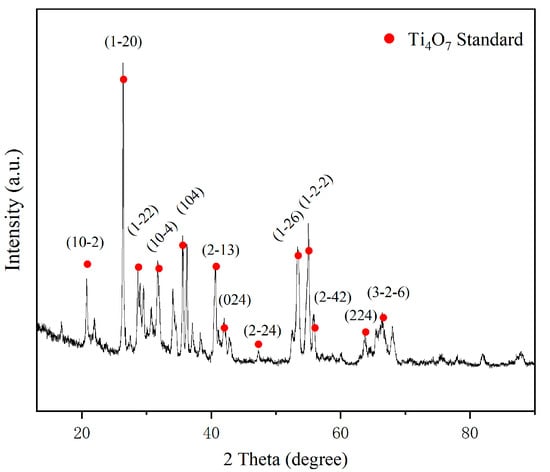
Figure 1.
XRD pattern of the Ti4O7 REM.
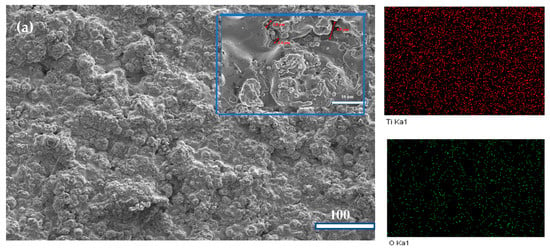
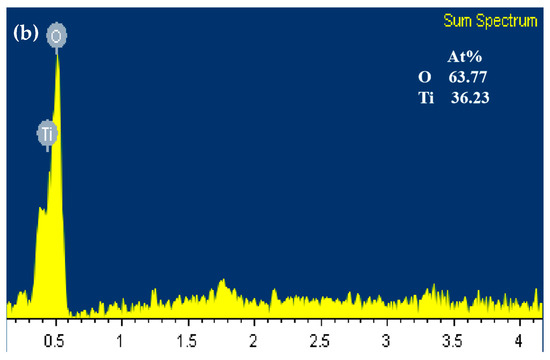
Figure 2.
(a) SEM image and (b) EDX surface scan result of the Ti4O7 REM.
3.2. Mass Transfer Performance
Electrochemical oxidation performance is dependent on the reaction kinetics and the transport of organic compounds to the electrode surface. Since the actual electron transfer step is extremely fast (~10−16 s) [18], the measured rate constant is limited by the mass transfer process. Here, the mass transfer performance in two operations was investigated. A CA measurement was performed to evaluate the mass transfer performance of the Ti4O7 REM in the TB system and FT system. As can be seen from Figure 3, the Ti4O7 REM in the TB system and FT system decreased rapidly after 6 s and then maintained a stable value of 2 mA/cm2 and 8 mA/cm2, respectively, indicating that the mass transfer of the Ti4O7 REM in the FT system was significantly higher than that in the TB system. This may be due to the fact that the oxalic acid molecule inevitably slipped away with the continuous stirred solution and bypassed the electrode surface in the TB system [26]. When the reactor operated in the FT system, the oxalic acid molecule would be forced across the porous structure by the enhanced convection, thus facilitating the mass transfer of organics to the electrode surface [27].
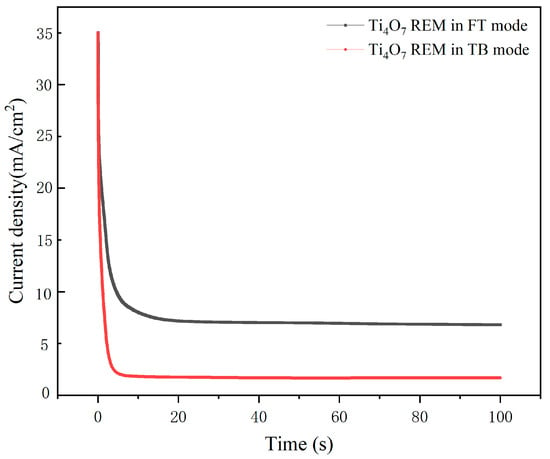
Figure 3.
CA analysis of Ti4O7 REM compared between FT mode and TB mode.
To intuitively compare the mass transfer performance of the Ti4O7 REM in two systems, CFD simulation was performed (Figure 4). Two important parameters, including turbulence intensity and velocity distribution, which control the thickness of the diffusion layer, were investigated. As presented, the high flow velocity in the TB system only existed close to the stirring area, and the flow velocity around the electrode was very low and chaotic, which resulted in heterogeneous velocity distribution and the formation of turbulent flow. Compared with the TB system, the FT operation showed a more uniform velocity distribution across the electrode interface, and thus could not form large-scale turbulence in the reactor. Moreover, the flow velocity across the electrode surface in the FT system was obviously higher than that of the TB system, which could meet the requirement of water flux. Therefore, it can be proved that the FT operation was more conducive to enhance the mass transfer performance compared with the TB mode based on the CFD simulation, which was consistent with the CA experiment. Consequently, subsequent electrochemical oxidation experiments were carried out in the FT system.
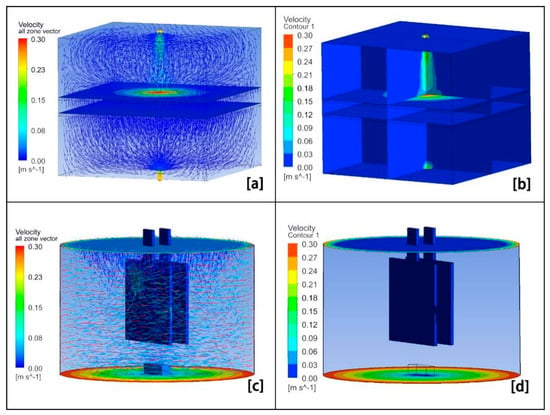
Figure 4.
The velocity distribution (a) and turbulence intensity (b) of Ti4O7 REM in FT mode; the velocity distribution (c) and turbulence intensity (d) of Ti4O7 REM in TB mode.
In each validation test, two points were selected as the research objects. In the FT reactor, the points of the central positions of the anode surface and the cathode surface were selected. And in the TB reactor, the mid-point between cathode and anode and the central position of the anode surface was selected. The simulated and experimental values of the two reactors under different boundary conditions were compared. As shown in Figure S7, the standard deviation between the simulated value and the experimental value was less than 5%, and thus the accuracy of the model was verified.
3.3. Effect of Current Density
Figure 5 shows the effect of current density on the COD removal efficiency of coking wastewater via electrochemical oxidation using the Ti4O7 REM. As presented, the COD removal rates showed accelerative trends with the applied current density. The COD removal efficiencies were 60.0%, 66.7%, 75.0%, and 77.6% for the applied current densities of 5, 10, 15, and 20 mA/cm2, respectively. However, when the current density was over 15 mA/cm2, the COD removal could not be improved significantly by further increasing the current density. This is due to the fact that the mass transfer of organic compounds to the anode surface was limited by the side reaction at higher current densities [28]. As a result, the optimal current density for the electrochemical oxidation of coking wastewater was determined to be at 15 mA/cm2.
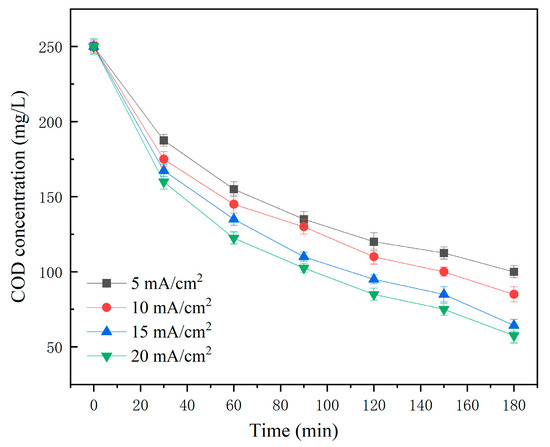
Figure 5.
The effect of current density on COD removal.
3.4. Effect of Anode–Cathode Distance
Figure 6 reveals the effect of anode–cathode distance (5 mm, 10 mm, 15 mm, and 20 mm) on the COD removal efficiency. As shown in Figure 6, the COD removal efficiencies were 72.3%, 75.4%, 68.4%, and 65.6% for distances of 5, 10, 15, and 20 mm, respectively. When the anode–cathode distance was smaller than 10 mm, the COD removal efficiency decreased. However, when the distance was greater than 10 mm, the COD removal decreased with the increase in the anode–cathode distance. This may be attributed to the longer diffusion distance which resulted from the larger anode–cathode. However, a very small anode–cathode distance was prone to short circuiting and generated a short-circuit current [29].
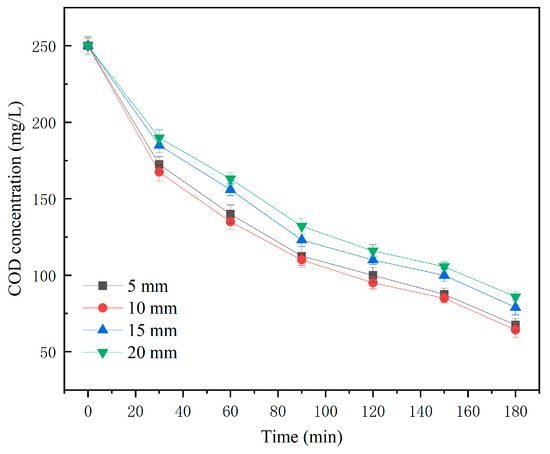
Figure 6.
The effect of anode–cathode distance on COD removal.
3.5. Energy Consumption
The energy consumption and current efficiency of the Ti4O7 REM in coking wastewater were investigated under an optimal current density of 15 mA/cm2 and anode–cathode distance of 10 mm. Figure S8 shows the energy consumption and current efficiency as a function of electrolysis times during the electrochemical oxidation process. The energy consumption curve shows a trend of decreasing followed by increasing, while the current efficiency curve indicates an opposite trend of increasing first and then decreasing. At the beginning, the concentration of •OH generated at the anode surface was too low, so that the organic compounds could not be fully degraded, resulting in high electrode energy consumption. As the electrolysis proceeded, more •OH was produced, and more pollutants were degraded accordingly, resulting in the improved current efficiency and declined energy consumption of the Ti4O7 REM. However, after a period of treatment, the polarization of organic contaminants around the electrode was significant. Moreover, the side reaction and mass transfer limitation made the pollutant degradation weaker, which contributed to the reduced current efficiency and far more energy consumption. After 3 h of electrolysis, the energy consumption for COD removal via Ti4O7 anode oxidation would be 110.5 kWh kg −1COD, which was much higher than that of Ti/SnO2-Sb anode [29], and comparable to that of BDD anode [3,30].
3.6. Electrode Stability and Cathodic Polarization
Previous studies had reported that the activity degradation of Magnéli Ti4O7 with long-term application was observed due to the formation of a passivation layer on the electrode surface [31]. Bejan et al. found that anode activity improved when the anode was polarized previously by the cathode during the electrochemical oxidation of p-nitrosodimethylaniline [32]. In this experiment, COD degradation using Ti4O7 REMs under cathodic polarization and non-polarization was compared. As shown in Figure 7, the effect of cathodic polarization could be observed when the anode was cathodically polarized for 2 h before each test cycle. Although the Ti4O7 REM without cathodic polarization exhibited satisfactory stability, the effect of cathodic polarization resulted in better long-term electrode performance.
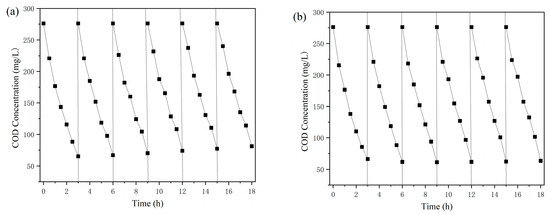
Figure 7.
(a) COD degradation for 6 consecutive experiments without cathodic polarization; (b) COD degradation for 6 experiments with cathodic polarization using Ti4O7 REM.
The COD removal efficiencies are listed in Table 1. For the Ti4O7 REM without cathodic polarization, the COD removal gradually declined from 76.2% to 73.1%. Interestingly, an improvement in anodic reactivity was found in the second cycle with the effect of cathodic polarization, in which the COD removal increased from 76.3% to 77.6%. Although the anodic activity still slightly degraded gradually with the increase in cycling times, the rate of decline was much lower than that without cathode polarization. The results indicated that cathodic polarization could slow down the formation of the surface passivation layer, and thus improve the electrode activity.

Table 1.
Comparison of COD removal among cycling experiments with and without cathodic polarization.
3.7. Treatment of Real Wastewater
Figure 8 presents the three-dimensional fluorescence spectra of the coking wastewater before and after treatment. As shown in Figure 8a, the most intense fluorescence center of the coking wastewater was positioned at Ex/Em = 310/400. Table S1 shows the excitation and emission wavelengths of the peaks of different fluorescent substances [29]. Therefore, the compounds in the coking wastewater were mainly humic acids, which was consistent with the previous study [29]. The fluorescence intensity of the coking wastewater after treatment was greatly reduced (Figure 8b), suggesting that the electrochemical oxidation has a favorable catalytic effect on soluble contaminants in the coking wastewater.
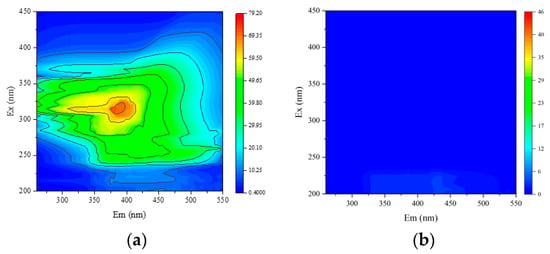
Figure 8.
Three-dimensional fluorescence spectra before (a) and after (b) electrolysis.
UV-vis spectroscopy has been widely used to characterize the properties of organic matter in coking wastewater through the identification of peaks and UV parameters. In this work, UV-vis spectra in the wavelength range of 180–500 nm were conducted before and after electrochemical oxidation for 3 h using the Ti4O7 REM. As shown in Figure 9, strong absorption peaks at 200–250 nm were found, indicating that single-ring aromatic compounds such as phenol and aniline were present in coking wastewater [33]. Furthermore, the adsorption band in the range of 300–370 nm was formed by polycyclic aromatic hydrocarbons and heterocyclic organic compounds, which suggested that the coking wastewater probably comprises aromatic compounds and heterocyclic substances [29,34]. The peak intensity decreased significantly as the degradation time increased, indicating that organic compounds, including single-ring aromatic compounds, polycyclic aromatic hydrocarbons, and heterocyclic organic compounds, could be degraded during the electrochemical oxidation process.
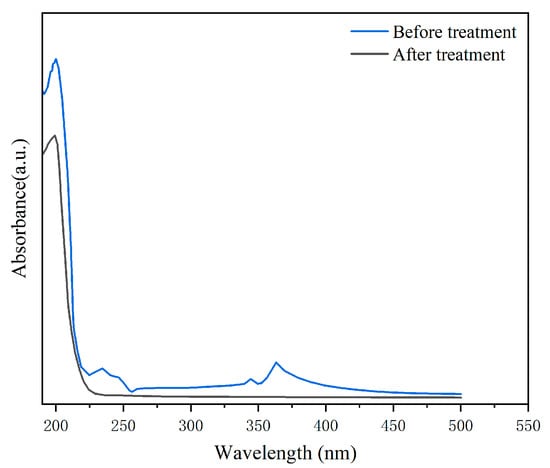
Figure 9.
UV-vis spectra of different electrolysis time.
4. Discussion
He et al. [29] reported that the Ti/SnO2-Sb electrode was utilized for the treatment of coking wastewater. The COD removal efficiency reached 83.05% with an energy consumption of 396.56 kWh (kg COD) −1 under the optimal conditions (current density of 25 mA m−2, Na2SO4 concentration of 35 mM, and plate spacing of 10 mm). Obviously, the energy consumption of the Ti/SnO2-Sb electrode was much higher than that of the Ti4O7 REM in our work. It was noted that the initial COD concentration dealt with in the study of He et al. [29] was 230 ± 20 mg/L, which was similar to that in our study (250 ± 20 mg/L), showing major similarity. Wang et al. [3] used the BDD anode to treat coking wastewater with an orthogonal experiment, indicating that the current was the main influencing factor, and the energy consumption for COD removal would be 88.1 kW h kg−1 COD. Less energy consumption might be related to the short electrolysis time and lower initial COD concentration (220 mg/L). These results showed that the Ti4O7 REM developed using a plasma spraying method has an advantage of an economical saving in the treatment of coking wastewater.
Chaplin et al. [15] proved that Ebonex electrode exhibited a promising mass transfer performance due to its advection-enhanced mass transfer rate, which was 10-fold higher than those obtained in traditional flow-by mode. Lin et al. [35] estimated the mass transfer rate of porous Ti4O7 anode in a batch reactor using the limiting current method. In this work, the mass transfer performance of the Ti4O7 REM in two operations was compared using CFD simulation for the first time, suggesting that the FT operation was more conducive to enhance mass transfer due to its uniform flow rate.
5. Conclusions
The Ti4O7 REM was successfully prepared using plasma spraying technology, which could effectively be used for the treatment of coking wastewater. The following results were obtained:
- The surface of the prepared Ti4O7 REM was proven to be highly pure and uniform by the characterization of XRD and SEM.
- CFD simulation was employed to compare the mass transfer performance of the Ti4O7 REM in TB mode and FT mode, indicating that the FT operation was more conducive to enhance mass transfer, which correlated well with the CA result.
- In the FT mode, the effect of current density and anode–cathode distance on the COD removal efficiency was investigated. The results showed that the COD removal efficiencies increased with the applied current density and decreased with the increase in the anode–cathode distance. The COD removal efficiency of the Ti4O7 REM could reach 76.2% with an energy consumption of 110.5 kWh kg−1 COD under the optimal condition.
- The Ti4O7 REM exhibited satisfactory stability during cycling experiments. However, the effect of cathodic polarization could result in better long-term electrode performance.
- According to the three-dimensional fluorescence analysis, the characteristic peak of humic acid in the coking wastewater disappeared, which suggested that the Ti4O7 REM had excellent catalytic properties for dissolved organic matters. Based on the UV–vis analysis, the aromatic compounds and heterocyclic organic compounds were significantly degraded.
Thus, the Ti4O7 REM electrochemical oxidation process has been proven to be economically favorable and technologically feasible for application in treating coking wastewater. This study provided an insight into a “green” and ecological approach to wastewater treatment.
Supplementary Materials
The following supporting information can be downloaded at: https://www.mdpi.com/article/10.3390/su152115488/s1.
Author Contributions
Conceptualization, J.W. and J.M.; methodology, J.Y. and H.Y.; software, H.Y. and C.W.; validation, J.Y. and H.Y.; formal analysis, C.W.; investigation, J.Y.; resources, J.W.; data curation, J.Y.; writing—original draft preparation, J.Y. and H.Y.; writing—review and editing, J.W.; visualization, H.Y. and C.W.; supervision, J.M. and J.W.; project administration, J.W.; funding acquisition, J.W. All authors have read and agreed to the published version of the manuscript.
Funding
This research was funded by National Natural Science Foundation of China, grant number 51978658.
Institutional Review Board Statement
Not applicable.
Informed Consent Statement
Not applicable.
Data Availability Statement
Due to the privacy, the data is unavailable.
Acknowledgments
The authors would like to thank the Water Treatment Engineering Innovation Lab for technical supporting.
Conflicts of Interest
The authors declare no conflict of interest.
References
- Radjenovic, J.; Sedlak, D.L. Challenges and Opportunities for Electrochemical Processes as Next-Generation Technologies for the Treatment of Contaminated Water. Environ. Sci. Technol. 2015, 49, 11292–11302. [Google Scholar] [CrossRef] [PubMed]
- Pitas, V.; Somogyi, V.; Karpati, A.; Thury, P.; Frater, T. Reduction of chemical oxygen demand in a conventional activated sludge system treating coke oven wastewater. J. Clean. Prod. 2020, 273, 122482. [Google Scholar] [CrossRef]
- Wang, C.; Zhang, M.; Liu, W.; Ye, M.; Su, F. Effluent characteristics of advanced treatment for biotreated coking wastewater by electrochemical technology using BDD anodes. Environ. Sci. Pollut. Res. 2015, 22, 6827–6834. [Google Scholar] [CrossRef] [PubMed]
- Yuan, X.; Sun, H.; Guo, D. The removal of COD from coking wastewater using extraction replacement-biodegradation coupling. Desalination 2012, 289, 45–50. [Google Scholar] [CrossRef]
- Ren, J.; Li, J.; Xu, Z.; Liu, Y.; Cheng, F. Simultaneous anti-fouling and flux-enhanced membrane distillation via incorporating graphene oxide on PTFE membrane for coking wastewater treatment. Appl. Surf. Sci. 2020, 531, 147349. [Google Scholar] [CrossRef]
- Abdelrazeq, H.; Khraisheh, M.; Ashraf, H.M.; Ebrahimi, P.; Kunju, A. Sustainable Innovation in Membrane Technologies for Produced Water Treatment: Challenges and Limitations. Sustainability 2021, 13, 6759. [Google Scholar] [CrossRef]
- Yang, K.; Lin, H.; Liang, S.; Xie, R.; Lv, S.; Niu, J.; Chen, J.; Hu, Y. A reactive electrochemical filter system with an excellent penetration flux porous Ti/SnO2-Sb filter for efficient contaminant removal from water. Rsc Adv. 2018, 8, 13933–13944. [Google Scholar] [CrossRef]
- Lin, H.; Xiao, R.; Xie, R.; Yang, L.; Tang, C.; Wang, R.; Chen, J.; Lv, S.; Huang, Q. Defect Engineering on a Ti4O7 Electrode by Ce3+ Doping for the Efficient Electrooxidation of Perfluorooctanesulfonate. Environ. Sci. Technol. 2021, 55, 2597–2607. [Google Scholar] [CrossRef]
- Rada, E.C.; Istrate, I.A.; Ragazzi, M.; Andreottola, G.; Torretta, V. Analysis of Electro-Oxidation Suitability for Landfill Leachate Treatment through an Experimental Study. Sustainability 2013, 5, 3960–3975. [Google Scholar] [CrossRef]
- Xu, D.; Song, X.; Qi, W.; Wang, H.; Bian, Z. Degradation mechanism, kinetics, and toxicity investigation of 4-bromophenol by electrochemical reduction and oxidation with Pd-Fe/graphene catalytic cathodes. Chem. Eng. J. 2018, 333, 477–485. [Google Scholar] [CrossRef]
- Kumar, A.; Barbhuiya, N.H.; Singh, S.P. Magneli phase titanium sub-oxides synthesis, fabrication and its application for environmental remediation: Current status and prospect. Chemosphere 2022, 307, 135878. [Google Scholar] [CrossRef]
- Wang, X.; Tang, Y.; Lee, J.-M.; Fu, G. Recent advances in rare-earth-based materials for electrocatalysis. Chem Catal. 2022, 2, 967–1008. [Google Scholar] [CrossRef]
- Wang, W.; Wang, K.; Hao, W.; Zhang, T.; Liu, Y.; Yu, L.; Li, W. Preparation of Ti-based Yb-doped SnO2-RuO2 electrode and electrochemical oxidation treatment of coking wastewater. J. Rare Earths 2022, 40, 763–771. [Google Scholar] [CrossRef]
- Hossain, M.K.; Rubel, M.H.K.; Akbar, M.A.; Ahmed, M.H.; Haque, N.; Rahman, M.F.; Hossain, J.; Hossain, K.M. A review on recent applications and future prospects of rare earth oxides in corrosion and thermal barrier coatings, catalysts, tribological, and environmental sectors. Ceram. Int. 2022, 48, 32588–32612. [Google Scholar] [CrossRef]
- Zaky, A.M.; Chaplin, B.P. Porous Substoichiometric TiO2 Anodes as Reactive Electrochemical Membranes for Water Treatment. Environ. Sci. Technol. 2013, 47, 6554–6563. [Google Scholar] [CrossRef]
- Guo, L.; Jing, Y.; Chaplin, B.P. Development and Characterization of Ultrafiltration TiO2 Magneli Phase Reactive Electrochemical Membranes. Environ. Sci. Technol. 2016, 50, 1428–1436. [Google Scholar] [CrossRef] [PubMed]
- Gayen, P.; Chen, C.; Abiade, J.T.; Chaplin, B.P. Electrochemical Oxidation of Atrazine and Clothianidin on Bi-doped SnO2-TinO2n−1 Electrocatalytic Reactive Electrochemical Membranes. Environ. Sci. Technol. 2018, 52, 12675–12684. [Google Scholar] [CrossRef] [PubMed]
- Chaplin, B.P. Critical review of electrochemical advanced oxidation processes for water treatment applications. Environ. Sci. Process. Impacts 2014, 16, 1182–1203. [Google Scholar] [CrossRef] [PubMed]
- Donaghue, A.; Chaplin, B.P. Effect of Select Organic Compounds on Perchlorate Formation at Boron-doped Diamond Film Anodes. Environ. Sci. Technol. 2013, 47, 12391–12399. [Google Scholar] [CrossRef]
- Napoles-Armenta, J.; Vidales-Contreras, J.A.; Leyva-Soto, L.A.; Meza-Escalante, E.R.; Diaz-Tenorio, L.M.; Garcia-Gomez, C.; Martinez-Orozco, E.; De La Mora-orozco, C.; Gortares-Moroyoqui, P.; Salcedo-Gastelum, L.A. The Influence of the Configuration of Two Electrochemical Reactors on the Process of Removing Atrazine from Water. Sustainability 2021, 13, 5267. [Google Scholar] [CrossRef]
- Schnoor, M.H.; Vecitis, C.D. Quantitative Examination of Aqueous Ferrocyanide Oxidation in a Carbon Nanotube Electrochemical Filter: Effects of Flow Rate, Ionic Strength, and Cathode Material. J. Phys. Chem. C 2013, 117, 2855–2867. [Google Scholar] [CrossRef]
- Nayak, S.; Chaplin, B.P. Fabrication and characterization of porous, conductive, monolithic Ti4O7 electrodes. Electrochim. Acta 2018, 263, 299–310. [Google Scholar] [CrossRef]
- Ganiyu, S.O.; Oturan, N.; Raffy, S.; Cretin, M.; Causserand, C.; Oturan, M.A. Efficiency of plasma elaborated sub-stoichiometric titanium oxide (Ti4O7) ceramic electrode for advanced electrochemical degradation of paracetamol: In different electrolyte media. Sep. Purif. Technol. 2019, 208, 142–152. [Google Scholar] [CrossRef]
- Zhuo, Q.; Yang, Z.; Qiu, Y.; Yang, B.; Wang, A.; Yu, G.; Zhang, Z. A facile synthesis of a novel Ti4O7 anode rich in oxygen defects and its electrochemical oxidation of florfenicol: Performance and mechanism. Sep. Purif. Technol. 2023, 310, 123134. [Google Scholar] [CrossRef]
- Yang, Y.; Hoffmann, M.R. Synthesis and Stabilization of Blue-Black TiO2 Nanotube Arrays for Electrochemical Oxidant Generation and Wastewater Treatment. Environ. Sci. Technol. 2016, 50, 11888–11894. [Google Scholar] [CrossRef]
- Shukla, P.; Singh, K.K.; Tewari, P.K.; Gupta, P.K. Numerical simulation of flow electrolysers: Effect of obstacles. Electrochim. Acta 2012, 79, 57–66. [Google Scholar] [CrossRef]
- Wang, J.; Li, T.; Zhou, M.; Li, X.; Yu, J. Characterization of hydrodynamics and mass transfer in two types of tubular electrochemical reactors. Electrochim. Acta 2015, 173, 698–704. [Google Scholar] [CrossRef]
- Silva Barni, M.F.; Doumic, L.I.; Procaccini, R.A.; Ayude, M.A.; Romeo, H.E. Layered platforms of Ti4O7 as flow-through anodes for intensifying the electro-oxidation of bentazon. J. Environ. Manag. 2020, 263, 110403. [Google Scholar] [CrossRef] [PubMed]
- He, L.; Wang, C.; Chen, X.; Jiang, L.; Ji, Y.; Li, H.; Liu, Y.; Wang, J. Preparation of Tin-Antimony anode modified with carbon nanotubes for electrochemical treatment of coking wastewater. Chemosphere 2022, 288, 132362. [Google Scholar] [CrossRef]
- Zhou, X.; Hou, Z.; Lv, L.; Song, J.; Yin, Z. Electro-Fenton with peroxi-coagulation as a feasible pre-treatment for high-strength refractory coke plant wastewater: Parameters optimization, removal behavior and kinetics analysis. Chemosphere 2020, 238, 124649. [Google Scholar] [CrossRef]
- Waraksa, C.C.; Chen, G.Y.; Macdonald, D.D.; Mallouk, T.E. EIS studies of porous oxygen electrodes with discrete particles—II. Transmission line modeling. J. Electrochem. Soc. 2003, 150, E429–E437. [Google Scholar] [CrossRef]
- Bejan, D.; Malcolm, J.D.; Morrison, L.; Bunce, N.J. Mechanistic investigation of the conductive ceramic Ebonex (R) as an anode material. Electrochim. Acta 2009, 54, 5548–5556. [Google Scholar] [CrossRef]
- Wang, Y.; Sun, S.; Ding, G.; Wang, H. Electrochemical Degradation Characteristics of Refractory Organic Pollutants in Coking Wastewater on Multiwall Carbon Nanotube-Modified Electrode. J. Nanomater. 2012, 2012, 614032. [Google Scholar] [CrossRef]
- Wei, C.; Wu, H.; Kong, Q.; Wei, J.; Feng, C.; Qiu, G.; Wei, C.; Li, F. Residual chemical oxygen demand (COD) fractionation in bio-treated coking wastewater integrating solution property characterization. J. Environ. Manag. 2019, 246, 324–333. [Google Scholar] [CrossRef]
- Lin, H.; Niu, J.; Liang, S.; Wang, C.; Wang, Y.; Jin, F.; Luo, Q.; Chiang, S.-Y.D.; Huang, Q. Development of macroporous Magneli phase Ti4O7 ceramic materials: As an efficient anode for mineralization of poly- and perfluoroalkyl substances. Chem. Eng. J. 2019, 359, 827. [Google Scholar] [CrossRef]
Disclaimer/Publisher’s Note: The statements, opinions and data contained in all publications are solely those of the individual author(s) and contributor(s) and not of MDPI and/or the editor(s). MDPI and/or the editor(s) disclaim responsibility for any injury to people or property resulting from any ideas, methods, instructions or products referred to in the content. |
© 2023 by the authors. Licensee MDPI, Basel, Switzerland. This article is an open access article distributed under the terms and conditions of the Creative Commons Attribution (CC BY) license (https://creativecommons.org/licenses/by/4.0/).